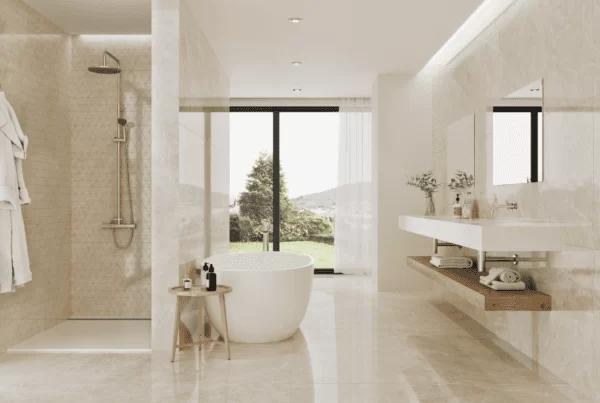History of ceramic and porcelain tiles, and a simple explanation of the production of ceramics
Porcelain tiles and slabs have become very widespread and common to use around the world. Not only do people use them for worktops, tables, and doors now, they are also the most popular material that is used for walls and floors, not only in residential homes only, but also in offices, warehouses, restaurants, and other types of companies. This is because although porcelain tiles have been crafted across the globe for thousands of years, today, updates in design and manufacturing technologies have changed porcelain tiles dramatically, making them more durable, easy-to-clean, and versatile than they ever have been.
Nowadays you find that porcelain comes in a very wide variety of colours, so that no matter what your preference or choice is, you will find the exact colour that you are after. Moreover, porcelain tiles come in so many different thicknesses nowadays, and so they will be compatible with any other feature you would like to install, such as a thin pillar, underfloor heating, and other such factors that set certain thickness criteria. Furthermore, porcelain tiles are now produced in many different sizes, and so you will be able to find the same colour and design but have less wastage as you can use the smaller ones for smaller rooms or spaces. Porcelain tiles also come in many different designs, and so you can choose to make your home more exclusive and unique, instead of getting the same kind sort of general design that the most other people have installed in their homes. But how do you make such brilliant tiles, without costing too much of a fortune and without spending too long on them?
Porcelain came about during the 15th century as most evidence leads to, but it was inspired by the much older ceramic, which is a material that is believed to have been used before 4,700 B.C. by the romans, meaning over 6,700 years ago! Now that is true heritage. Even when porcelain tiles started being produced around 600 years ago, they were not widely used in a typical building as wall cladding or to cover the floors, it was still the earthenware (terracotta), stoneware and ceramic tiles that were most commonly used for this purpose. Ceramic tiles are produced in a very similar way to porcelain, but there are still a few changes to the method, and so this is why ceramic tiles have got very much different properties and characteristics compared to porcelain tiles, which we will explore after explaining the steps that manufacturers take to produce ceramic tiles, in a more simple manner of course.
Initially, the materials required for the production of the tiles must be gathered in some sort of way and brought and transported to the production hub. Both porcelain and ceramic tiles use clay in their production, but porcelain tiles typically use heavier, denser clays than your average ceramic tile. Clay is a perfect material to start off with, because it is very easy to find, widely available (unlike some very rare materials that become very expensive as they are worth a lot), and it is not difficult to extract, as some minerals and rocks are only found underground, and so a whole mining site must be set up to extract those, which is not an easy task at all, and so it takes longer and costs much more. Plus, relative to other materials used in manufacturing, clay is not a very heavy material, and so it does not pose any difficult hurdle to bypass when transported.
The natural clay used in ceramics is either the red, brown, or white. In porcelain, it is only the white clay that is used, and it is modified a little before production, as it is added in with two main ingredients – kaolin and petuntse – which make the clay much stronger and tightly held, and also allows for a much smoother surface compared to ceramics toward the end of the manufacturing line. The alumina of the clay, metal oxides (such as Sodium oxide, Potassium oxide or even Calcium oxide) and silica are mixed in very large amounts, and sometimes, water is added as well, so that the ingredients are wet milled or ground in a ball mill, just to ease the process a little further. The vast mixture is then fired at a very high temperature to reduce the water content, and if wet milling is used, then the excess water is removed using filter pressing followed by spray drying. With regards to porcelain, as it consists of a much more hardwearing and modified sort of clay, it can withstand higher temperatures, and so it is fired at temperatures that reach 1,200 degrees Celsius, and so therefore porcelain tiles become even more tightly held, contain a smoother surface and much less stain resistant. As a result of the heating, a powder residue is left behind, which is the main mould of ceramics. The various colours of the mould of course result from the type of clay initially used, and so these colours can be mixed in certain ways to produce veins and shapes and other designs, but also to produce other shades of those brownish or reddish colours of the clay.
The powder residue of various colours is pressed into the desired tile shape, only to be exposed to extremely high levels of heat and pressure. The fact that it is pressed so tightly in turn reduces the pores in ceramic tiles, which makes them much more stain resistant, easy to clean and longer lasting compared to many other types of stone or materials, and that is why ceramic tiles are very suitable for use behind showers for example, or in other such damp areas for that matter. The ceramic tiles are then glazed once they are cooked in a huge furnace, to become very nicely coloured and polished, reflecting light and becoming very eye-catching and glamorous to look at. However, porcelain tiles are that much more durable and more stain-resistant, as they are fired at higher temperatures, and the clay used to produce them is more refined, therefore there are still less pores on the surface, and the glazing becomes much more accurately done, and the surface is smoother and better made, so porcelain looks even more fascinating, and much more eye-catching as porcelain can achieve a much more mesmerising polish on its surface, and replicate natural stone designs much more accurately too.
Therefore, we can see that ceramics have been used for the past thousands of years, in all sorts of applications, as it has been such a great discovery since that time. However, as technology has progressed, we have developed porcelain tiles, who are even nicer looking than ceramics, more cost effective, and much easier to transport or install. This is why most people are moving onto using porcelain tiles for their homes and offices. Porcelain can be shaped into many more shapes and sizes compared to ceramics, and it comes in a much wider variety of colours and designs…and so even though ceramics is the cause of the development of porcelain, porcelain is the more recent and more suitable for use these days.



